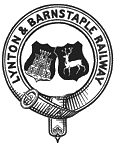
Pilton railway station
Encyclopedia

Pilton, Devon
Pilton is a suburb of Barnstaple. It is located about half a mile north on the outskirts of Barnstaple in Devon, England. It is home to about 2000 residents, and has its own primary and secondary school...
, to the north of Barnstaple
Barnstaple
Barnstaple is a town and civil parish in the local government district of North Devon in the county of Devon, England, UK. It lies west southwest of Bristol, north of Plymouth and northwest of the county town of Exeter. The old spelling Barnstable is now obsolete.It is the main town of the...
was, between 1895 and 1935, the main depot and operating centre of the Lynton and Barnstaple Railway
Lynton and Barnstaple Railway
The Lynton & Barnstaple Railway opened as an independent railway in May 1898. It was a single track narrow gauge railway slightly over long running through the rugged and picturesque area bordering Exmoor in North Devon, England. Although opened after the 1896 Light Railways Act came into force,...
('L&B'), a narrow gauge line that ran through Exmoor
Exmoor
Exmoor is an area of hilly open moorland in west Somerset and north Devon in South West England, named after the main river that flows out of the district, the River Exe. The moor has given its name to a National Park, which includes the Brendon Hills, the East Lyn Valley, the Vale of Porlock and ...
from Barnstaple to Lynton
Lynton
Lynton is a small town in Devon, England. It lies on the northern edge of Exmoor and is located at the top of a gorge above Lynmouth, to which it is connected by the Lynton and Lynmouth Cliff Railway...
and Lynmouth
Lynmouth
Lynmouth is a village in Devon, England, on the north edge of Exmoor.The village straddles the confluence of the West Lyn and East Lyn rivers, in a gorge below Lynton, to which it is connected by the Lynton and Lynmouth Cliff Railway....
in north Devon
Devon
Devon is a large county in southwestern England. The county is sometimes referred to as Devonshire, although the term is rarely used inside the county itself as the county has never been officially "shired", it often indicates a traditional or historical context.The county shares borders with...
. Goods facilities were also provided at Pilton, but passengers were catered for at the nearby LSWR station, Barnstaple Town
Barnstaple Town railway station
Barnstaple Town was an intermediate station on the L&SWR line to Ilfracombe. The station replaced Barnstaple Quay – opened in 1854, and renamed Barnstaple Town in 1886 – which had been located on the Junction side of the Commercial Road crossing, a short distance up-line...
, which provided connections with trains on the standard gauge
Standard gauge
The standard gauge is a widely-used track gauge . Approximately 60% of the world's existing railway lines are built to this gauge...
branch line to Ilfracombe
Ilfracombe Branch Line
The Ilfracombe Branch of the London & South Western Railway , ran between Barnstaple and Ilfracombe in North Devon. The branch opened as a single-track line in 1874, but was sufficiently popular that it needed to be upgraded to double-track in 1889....
. The L&B's main offices were also based at Pilton, in a building formerly belonging to the Tannery which had earlier occupied the site, and which took over the site after the railway closed.
Pilton was the site of the L&B's only turntable. Locomotives always travelled with their boilers facing "down" the line, i.e. towards Lynton (down as it was away from London by rail, although geologically, Lynton was higher, and geographically nearer to London). The turntable was used to turn rolling stock periodically to even-out bearing wear. After closure, the turntable was installed at the Romney, Hythe & Dymchurch Railway in Kent
Kent
Kent is a county in southeast England, and is one of the home counties. It borders East Sussex, Surrey and Greater London and has a defined boundary with Essex in the middle of the Thames Estuary. The ceremonial county boundaries of Kent include the shire county of Kent and the unitary borough of...
, but is now owned by the Lynton and Barnstaple Railway Trust
Lynton and Barnstaple Railway Trust
The Lynton & Barnstaple Railway Trust is an educational charity supporting the rebuilding and operation of the railway by the Lynton & Barnstaple Railway Company, in North Devon, England.- Objects :...
and in storage for eventual restoration and reuse on the new L&B.
The carriage sheds, locomotive shed and other remnants of the railway were destroyed in a fire in 1992. Much of the site is now a car park, although there are still signs of its former railway use.

